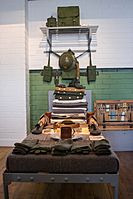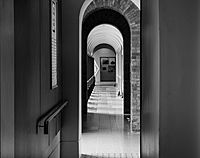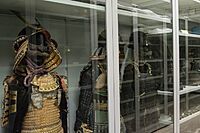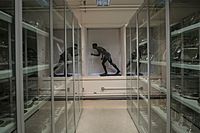National Museum of Ireland – Decorative Arts and History facts for kids
| Ard-Mhúsaem na hÉireann – Na hEalaíona Maisiúla ⁊ Stair | |
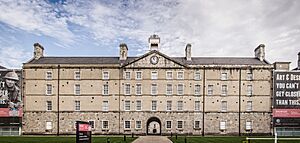
Front facade of Collins Barracks
|
|
| Lua error in Module:Location_map at line 420: attempt to index field 'wikibase' (a nil value). | |
| Established | 18 September 1997 |
|---|---|
| Location | Collins Barracks, Benburb Street, Dublin, Ireland |
| Type | National museum |
| Collection size | 150,000 items |
| Visitors | 198,974 (2018) |
| Public transit access | Museum Luas stop Dublin Bus routes: 25, 25a, 66, 67 |
| National Museum of Ireland network | |
|
|
The National Museum of Ireland – Decorative Arts and History is a super interesting museum in Dublin, Ireland. It's part of the National Museum of Ireland (NMI). You can find it at the old Collins Barracks building.
This museum shows off amazing collections of Irish history. It has items about military history and beautiful decorative arts. Some of its most important collections are about big Irish events like the Easter Rising.
Contents
Discovering Irish History at the Museum
How the Museum Started
The museum's Decorative Arts & History section began in 1877. Back then, it was called the Art and Industrial Division. It started alongside other museum sections like Natural History.
Early items were bought in 1878 and 1879. These included 121 objects from India and Persia. There were beautiful enamels, ceramics, and textiles. These joined collections from the Royal Dublin Society. The museum also borrowed items from the Victoria and Albert Museum in London.
When the main museum building opened on Kildare Street, it showed art and industry. These collections helped art students and workers learn from the best examples. By 1889, the Art and Industrial Division had over 10,000 objects.
Teaching Through Art and Industry
In the early 1900s, the art and industry collection was used for teaching. It helped people learn about different arts and crafts. Items were often loaned to the National College of Art and Design. Some collections even traveled around the country in special boxes. This was called the Circulation Collection.
This collection was very popular. But it stopped during World War I and never started again. The museum also held exhibitions. One was called Applications of Art and Industry. It showed local enamel work, lace, and tapestries. From 1908, the museum focused more on collecting "distinctively Irish" objects.
After Irish Independence
After Ireland became independent in 1922, the museum faced challenges. It had a smaller budget. It also lost many exhibition spaces. This happened when Leinster House became the new Irish parliament.
From then on, the art and industry division started collecting Irish military and political history items. The museum held its first exhibition on the Easter Rising in 1932. These objects became the core of the Easter Week Collection. This was the museum's first collection about modern events. Many items were given by the public.
The Albert Bender Asian Art Collection
In the 1930s, a man named Albert M. Bender donated a huge collection of Asian art. Bender was born in Dublin but lived in San Francisco. He was Jewish and gave his collection to the museum. Other big museums, like the Louvre, wanted it too.
The museum's director, Adolf Mahr, tried to stop Bender. He felt the museum wasn't "good enough" for such a collection. But Bender still donated items from 1932 to 1937. He did this to honor his mother, Augusta Bender. The "Augusta Bender Memorial Room of Far Eastern Art" opened in 1934. Éamon de Valera, a famous Irish leader, opened it.
Moving to Collins Barracks
In 1988, the Irish government decided to close Collins Barracks as a military base. In 1993, the NMI agreed to use it as a new museum campus. This was part of a plan to improve a neglected area of Dublin. The museum became the main part of a new "museum quarter."
The new Luas tram line was also built. This made it easier to get to the new museum. It also connected to the Irish Museum of Modern Art.
Opening the New Museum
The Office of Public Works spent three years getting the site ready. It cost £15 million. The museum opened in 1997. It had new exhibition and storage spaces. Many objects were displayed for the first time in years. A lecture theatre, restaurant, and education rooms were also added.
The museum's conservation lab and main offices are also at this site. In its first year, 200,000 people visited the museum. The new site also helped the museum expand its education programs. Minister Síle de Valera officially opened the museum in September 1997.
The museum has continued to grow. In 2002, it won an award for turning old army quarters into exhibition spaces. In 2018, nearly 200,000 people visited the museum.
Michael Collins' Slippers Go Viral
In March 2021, a pair of slippers in the museum's collection became famous online. A photo of curator Brenda Malone holding them was shared on Twitter. These bright blue slippers belonged to Michael Collins, a key figure in Irish history. His friend donated them in 1958. The slippers have a cool embroidered wolf head pattern. They have never been on public display, but the museum now plans to make gift items based on them.
Amazing Permanent Exhibitions
The museum has many cool displays. You can see Irish coins, silverware, furniture, and Asian art. There are also exhibits on folk life, costumes, ceramics, and glassware. Other permanent shows include What's In Store?, Out of Storage, Irish Silver Exhibition, and Irish Country Furniture.
In 2021, the museum announced a new gallery about the 20th century. It opened in 2023. This was part of the Decade of Centenaries program. It celebrated 100 years since the Irish Free State was founded. The government gave €2.2 million for this project.
Soldiers and Chiefs: Ireland's Military Story
The Soldiers and Chiefs - The Irish at War at Home and Abroad since 1550 exhibition is huge! It shows military items from 1550 to today. It opened in 2005 and covers a massive area.
The exhibition tells Ireland's military history in order. It covers different periods of military rule and development. It also shows the role of Irish soldiers in armies worldwide. This includes modern peacekeeping with the United Nations. This exhibition won an award for best exhibition in Ireland in 2009–2010.
One special item, The Stokes Tapestry, was featured in A History of Ireland in 100 Objects. The hat Michael Collins wore when he was shot was once on display. It was removed in 2005 for conservation reasons. However, the coat he wore that day is still on display.
Other galleries focus on Irish military history. Many remember the 100-year anniversaries of World War I and the Easter Rising. They also cover the Irish War of Independence and the Irish Civil War. One exhibition is about the Royal Dublin Fusiliers and Royal Munster Fusiliers at Gallipoli. Another shows the Irish who fought at Messines.
Proclaiming a Republic: The 1916 Rising
This exhibition is all about the 1916 Easter Rising. It opened in 2016 to mark 100 years since the event. It uses over 15,000 objects from the museum's Easter Week Collection. Taoiseach Enda Kenny opened it on March 3, 2016.
This was the museum's eighth exhibition on the Easter Rising. It showed many objects that had never been seen before. The exhibition has 10 sections. They follow the events of the Rising and its lasting impact. You can see items related to the leaders' executions. This includes the blood-stained shirt of James Connolly.
The Way We Wore: Irish Fashion Through Time
This exhibition, subtitled 250 Years of Irish Clothing and Jewellery, opened with the museum in 1997. It shows Irish clothing and jewelry from the 1760s to the 1960s. It was expanded in 2000. It was the biggest and most expensive historical costume exhibition in Ireland at the time.
The exhibition mostly features clothes from wealthier people. These were the clothes that were saved over time. You can also see outfits worn by the wives of Irish presidents. These include Sinéad de Valera and Maeve Hillery. The exhibition uses simple mannequins. Each outfit has a story next to it. You can see military outfits, formal dresses, and special Celtic Revival dresses.
Eileen Gray: A Design Genius
In 2000, the museum bought a large collection of works from designer Eileen Gray. It cost £900,000. The museum outbid the Centre Pompidou in Paris for these items. The collection included her personal objects, furniture, and models.
These items are now on permanent display. Dr Jennifer Goff curated the exhibition. It opened on March 22, 2002. You can see many of her most famous furniture designs here.
Curator's Choice: Special Objects
The Curator's Choice exhibition shows 25 objects picked by museum experts. These items come from all four museum divisions. You can see King William's gloves from the Battle of the Boyne. There's also a pocket book belonging to Wolfe Tone. An oar and life belt from the RMS Lusitania are also on display. One very special item is the Fonthill Vase, a Chinese porcelain vase from around 1300 AD.
Albert Bender's Asian Art Collection Returns
The exhibition of Albert Bender's collection was set up again at Collins Barracks in 2008. It had been shown at the Kildare Street museum from the 1930s to 1973. Bender was an Irish-born Jewish man who made a lot of money in insurance in San Francisco.
The new exhibition shows a selection of the 260 Asian art objects Bender donated. One important part is a set of rare thangkas. These are Buddhist tapestries from 18th-century Tibet. There are also Japanese woodblock prints, Chinese metalwork, and many religious figures. Dr Audrey Whitty curated this new exhibition.
Exciting Temporary Exhibitions
Special temporary exhibitions are often held in the former Riding School. This area opened in 2005. In summer 2007, replicas of six Irish High Crosses were shown. In 2019, an exhibition of 100 photos of Ireland in the 1950s was displayed. It was called Ireland in Focus. These photos were from the collection of Henri Cartier-Bresson.
Dead Zoo at Large
In 2009 and 2010, a temporary exhibition from the Natural History Division opened. It was called Dead Zoo at Large. This happened while the main Natural History museum was closed for repairs.
(A)Dressing Our Hidden Truths
In March 2019, the museum opened an exhibition called (A)Dressing Our Hidden Truths. Artist Alison Lowry and curator Dr Audrey Whitty created it. It explores tough topics like institutional abuse in Ireland. It reflects on the experiences of people in Magdalene Laundries and Mother and Baby Homes.
This exhibition won an "Honourable Mention" from the Annual Global Fine Arts Awards in 2019. It was also nominated for the Global Humanity category. Artists like Connie Roberts and Úna Burke were featured. The museum announced in 2021 that it would buy a glass piece from the exhibition, A New Skin.
Collecting Modern History
The museum started collecting items from modern Irish culture in the mid-2010s. This was in response to big events. The first was the 2015 vote on marriage equality. Curator Brenda Malone collected items from the political campaigns.
As part of the marriage equality collection, government minister Katherine Zappone donated her wedding dress in 2018. In 2019, Rory O'Neill, also known as Panti Bliss, donated a dress he wore. This was after his famous speech about homophobia at the Abbey Theatre. This work led the museum to create a formal Contemporary Collecting policy in 2019.
Gallery
-
The only extant Ashworth pillar box and oldest in Ireland introduced by Anthony Trollope



